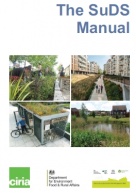The SUDS manual
On 13 November 2015, CIRIA (the Construction Industry Research and Information Association) published The SuDS Manual (C753). It was the result of a CIRIA research project (RP)992 and its preparation was guided by a project steering group.
SUDS (Sustainable urban drainage systems) are systems designed to manage the drainage of surface water in the urban environment, providing an alternative to, or addition to, traditional drainage systems that drain surface water into underground, piped drainage. SUDS techniques seek to capture, use, delay or absorb rainwater and include; filter strips and drains, swales, permeable surfaces, basins and ponds, underground storage, rainwater harvesting, and so on.
The SuDS Manual was first published in 2007 when SUDS was still a relatively new concept. The 2015 edition significantly revises the guidance to include the latest research and best practice. It complements by the government’s ‘non statutory technical standards’ but goes further, supporting the cost effective delivery of multiple benefits.
CIRIA describe C753 as the most comprehensive industry SuDS guidance available in the UK. It is intended to; support uptake, manage floods and create better places and spaces. It deals with the planning, design, construction, operation and maintenance of SuDS. It considers amenity and biodiversity and has supporting information about materials, landscape, community engagement, costs and benefits.
Its contents include:
- Introduction.
- Philosophy and approach.
- Applying the approach
- Technical detail.
- Supporting guidance.
- Appendices.
Its publication followed a ministerial statement by The Secretary of State for Communities and Local Government earlier in 2015 which made it clear that SuDS must play a greater role in the planning system, and that it is a requirement in new major developments wherever appropriate.
Paul Shaffer, Associate at CIRIA said:
“The SuDS Manual reflects CIRIA’s stance that well designed SuDS deliver multiple benefits, as well as manage local flood risk. The Manual is the cornerstone of CIRIA’s work on SuDS that includes the BeST project (Benefits of SuDS Tool), susdrain, CIRIA’s SuDS training and extensive catalogue of SuDS related guidance. CIRIA is also developing future work to improve SuDS construction, planning and assessment providing the industry with the competence and confidence to embrace SuDS fully.”
C753 is free to download, available from the CIRIA website.
[edit] Related articles on Designing Buildings Wiki
- Catchment flood management plans.
- Flood and Water Management Act.
- Flood insurance.
- Flood risk.
- Flood risk management plan.
- Future Water, The Government’s water strategy for England.
- Greywater.
- Pitt Review.
- Planning for floods.
- Rainwater harvesting.
- River engineering.
- SUDS.
- SuDS infographic.
- SuDS - is there light at the end of the tunnel?
- Sustainable urban drainage systems - latest guidance.
- Water Act 2014.
- Water consumption.
- Water engineering.
Featured articles and news
RTPI leader to become new CIOB Chief Executive Officer
Dr Victoria Hills MRTPI, FICE to take over after Caroline Gumble’s departure.
Social and affordable housing, a long term plan for delivery
The “Delivering a Decade of Renewal for Social and Affordable Housing” strategy sets out future path.
A change to adoptive architecture
Effects of global weather warming on architectural detailing, material choice and human interaction.
The proposed publicly owned and backed subsidiary of Homes England, to facilitate new homes.
How big is the problem and what can we do to mitigate the effects?
Overheating guidance and tools for building designers
A number of cool guides to help with the heat.
The UK's Modern Industrial Strategy: A 10 year plan
Previous consultation criticism, current key elements and general support with some persisting reservations.
Building Safety Regulator reforms
New roles, new staff and a new fast track service pave the way for a single construction regulator.
Architectural Technologist CPDs and Communications
CIAT CPD… and how you can do it!
Cooling centres and cool spaces
Managing extreme heat in cities by directing the public to places for heat stress relief and water sources.
Winter gardens: A brief history and warm variations
Extending the season with glass in different forms and terms.
Restoring Great Yarmouth's Winter Gardens
Transforming one of the least sustainable constructions imaginable.
Construction Skills Mission Board launch sector drive
Newly formed government and industry collaboration set strategy for recruiting an additional 100,000 construction workers a year.
New Architects Code comes into effect in September 2025
ARB Architects Code of Conduct and Practice available with ongoing consultation regarding guidance.
Welsh Skills Body (Medr) launches ambitious plan
The new skills body brings together funding and regulation of tertiary education and research for the devolved nation.
Paul Gandy FCIOB announced as next CIOB President
Former Tilbury Douglas CEO takes helm.
UK Infrastructure: A 10 Year Strategy. In brief with reactions
With the National Infrastructure and Service Transformation Authority (NISTA).























